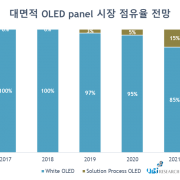According to “Market Entry Analysis for Solution Process OLED -The Possibilities and Opportunities” issued on November 14 by Ubiresearch, OLED TV, produced in solution process method, is prospected to be launched on the market in 2019.
Solution process is a technology which enables producing OLED panel in RGB pixel structure without any panel division on a device higher than G8, which major AMOLED panel producers has actively engaged in developing.
However, lamp efficiency and life cycle have no option to decrease because luminescent materials have lower purity than that of evaporation materials as luminescent materials applied to solution process should be mixed with various solvents in order to make the existing evaporation materials ink. Nevertheless, why major panel producers has actively engaged in developing solution process is that production cost can be declined as the usage efficiency of luminescent materials is high without using color filters and its structure is simpler than that of OLED panel using WRGB method.
According to the report, it is said that although developing luminescent materials for solution process OLED has been fully engaged, it should be more efficient than that of WRGB methods so as to enter the premium market. However, it seems substantially difficult that the capacity of solution process OLED surpasses that of WRGB as WRGB has been developed in top emission structure to improve its efficiency by over 20% and evaporation materials have also constantly been developed. Rather, based on proper level of life cycle and efficiency, it would be competitive to replace LCD targeting the mid-end TV market, according to the report.
Issues on OLED, QLED, hybrid QD, which can be applied to solution process and possibilities to enter the market, comparative analysis on the capacity of present solution process OLED, supply chain of QD industries, and major soluble OLED material producers are included in this “Market Entry Analysis for Solution Process OLED -The Possibilities and Opportunities” and it is expected to help the relevant producers understand the solution process industry.
Meanwhile, it is predicted that the market of large-scaled solution process OLED panel over 55 inch will begin in earnest being mass-produced as of 2019 and have accounted for the entire wide OLED panel market by approximately 15% growing by approximately US$ 1,000 million by 2021.











